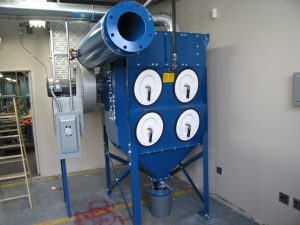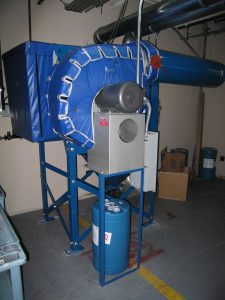“Fans and Dust Collectors in a Small Utility Room.”
Sound is OK; noise is not! Meeting OSHA’s permissible exposure limit (PEL) at 90 dBA for 8 hours and addressing the hearing protection requirement at 85 dBA is important because noise attenuation is part of a good ventilation system design. Particularly in industrial environments, where fans and blowers are necessities, with small and medium size fans operating at the production or mezzanine levels that have noise levels of 90 dBA to 105 dBA. If it’s noise, it’s objectionable even if it meets OSHA!
Reducing Fan and Blower Noise
Whether your fan is on a dust collector, sand blaster, is a fume exhauster, or process air intake fan, it is going to create noise from its exhaust or intake, through its fan casing and from its motor. Conventional solutions address all these noise sources. Typically, an industrial fan is ducted in or out, meaning that you may only have to treat the open fan end with a silencer (expect 5 dBA to 25 dBA noise reduction depending on silencer). But if the fan is very noisy, you may need acoustic lagging or wrap on the connected equipment or ductwork, on the ducted end of the fan and on the fan casing. This lagging is usually good for 5 dBA to 25 dBA noise reduction. And don’t forget the motor. If it’s large or high speed, its casing may need to be lagged as well.
 A common companion to a fan in manufacturing facilities is another noise generator, a dust collector. When the collector goes into a cleaning mode, noise levels from the compressed air backflush can be as high as 110 dBA. When required, this is handled by building an insulated box around the pulse valves or wrapping with noise blankets or lagging around the body of the collector.
A common companion to a fan in manufacturing facilities is another noise generator, a dust collector. When the collector goes into a cleaning mode, noise levels from the compressed air backflush can be as high as 110 dBA. When required, this is handled by building an insulated box around the pulse valves or wrapping with noise blankets or lagging around the body of the collector.
It can be an involved and sometimes expensive process to bring fan and dust collector noise down to 85 dBA in a work environment. The typical alternative is to place equipment in an isolated room or closet. This “utility” room has many advantages but knowing we will need to deal with sound transmission, absorption and reflection thru walls and ceiling, our construction materials need to be selected to meet our expectations for noise attenuation. If walls are constructed of 2 x 4 studs and drywall we shouldn’t expect to see much improvement but if a cement block wall, we’ll experience much better results.
Installing a Fan in a Small Utility Room
Housing the fan and associated equipment (i.e., dust collector) in a cement block room with a well-sealed industrial metal door will result in a 15 dBA to 25 dBA noise reduction to the listener positioned outside the room under the right circumstances. You can think of the room as replacing the lagging system. You will still need to attenuate the open end of the fan and duct it through a well-sealed room wall opening. The inlet or outlet duct from the fan will also need to enter/exit the room through a sealed opening. A side note, you need to consider the motor’s thermal load. It may be necessary to bring in and exhaust fresh air to cool the motor. With these steps, you should meet 85 dBA or less in the working area outside of the room.
Our example is for a single noise source. Most times several noise generators are in the same room. In that case we have logarithmic addition of noise sources to deal with. Two of the same noise source result in a 3 dBA increase in overall noise. View the case study here.

Dust collector with a fan outlet silencer, housing lagging or wrap and the cleaning section of fan blanketed to minimize compressed air pulsing noise.
But BE CAREFUL – The Noise Level in the Room Will Be 10 dBA to 15 dBA Higher
Before entering the room wear approved hearing protection or double hearing protection. The noise level in the fan room will be 10 dBA to 15 dBA higher than would have been measured on the plant floor where the fan noise dissipates before reflecting off walls. Inside the fan room, it’s like a tin can, with the instantaneous reflection off the walls will cause a build-up of reverberant noise.
With all things considered and with the right precautions taken, the noise proof fan room is the right solution for many fan (and associated equipment) related noise problems. Just remember, it’s going to be very noisy in the room. Wear hearing protection before going in.


